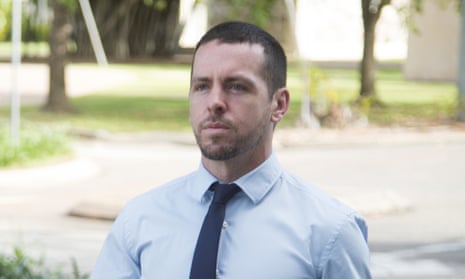Kumanjayi Walker would have probably survived being shot three times by Constable Zachary Rolfe had it happened in a city, the police officer’s murder trial has been told.
The Aboriginal teenager was shot three times during a failed arrest attempt in the remote community of Yuendumu, 290km north-west of Alice Springs, on 9 November 2019.
The 19-year-old died at the local police station 74 minutes after the second fatal shot “reached the end of its wound path”.
The court has heard Rolfe opened fire after Walker stabbed him in the shoulder with a pair of scissors. Prosecutors say Rolfe went “too far” when he fired the second and third shots, roughly 2.6 seconds after the first, because the teen was “effectively restrained” on the ground by another officer when the constable pulled the trigger.
The constable has pleaded not guilty to a murder charge, with defence lawyers arguing he was doing his job and defending himself and his fellow officer from a violent offender who had stabbed him and was struggling with his colleague. The defence also disputes that Walker had been effectively restrained at the time of those shots.
Expert witness Dr Michael Reade told the Northern Territory supreme court on Monday that Walker’s chances of survival would have been “extremely high” had he been shot nearer to a city hospital.
“I would be very surprised had he succumbed to those injuries. I estimated his chance of death would have been only around 1%,” he said. “But that is, of course, with almost immediate access to damage control surgery.”
Rolfe’s second bullet fired at 7.22pm ripped through the teen’s spleen, liver, left kidney and right lung as it tracked from one side of his body to the other.
“It had done such a degree of internal damage to the major organs and in particular the lung that it would have required, initially, advanced resuscitation techniques that [the police] were not capable of applying,” Reade said.
“Secondly, access to what we term damage control surgery. The closest available place was Alice Springs. That was too far away.”
An autopsy found Walker died at 8.36pm from blood loss and breathing difficulties caused by a collapsed lung.
Reade watched police body-worn camera footage of the efforts to save Walker’s life and said the officers giving first aid did all they could.
The court has previously heard “alarmed” medical staff had evacuated the community of about 800 over safety concerns earlier in the day after their homes were broken into the night before.
Reade said he was uncertain if the clinic’s nurses would have had all the necessary skills to have kept Walker alive long enough for him to be moved to Alice Springs had they stayed. The trial continues on Tuesday.
